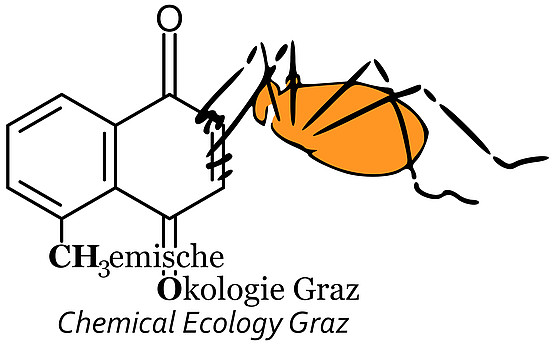FWF-Project P29699 "Chemosystematics in Harvestmen: 'Sclerosomatid Compounds'"
PI: Günther Raspotnig; project associate: Miriam Schaider
The taxon-specific scent gland secretions of harvestmen (Opiliones) represent a well suited model for the study of the evolution of phylogenetically old exocrine systems (“chemosystematics”). So far, approaches toward an evolutionary explanation of scent gland chemical diversity have mainly been limited to the phenol/benzoquinone-rich secretions of Laniatores. A major, predominant class of scent gland chemicals, however, is represented by characteristic acyclic compounds and their derivatives: the basic structure of these compounds shows an ethyl-ketone core with a methyl branch in position 4. Initially found in eupnoan harvestmen of family Sclerosomatidae, these sclerosomatid compounds appear to be scattered all across the system of Opiliones, resurfacing in certain Dyspnoi, triaenonychoid Laniatores, a particular clade of gonyleptoid Laniatores (“K92”), and in modified form in Cyphophthalmi.
We hypothesize that “sclerosomatid compounds” (=SCs) constitute a major trait in opilionid scent gland chemistry, logically linking the distinct scent gland chemistry of major groups of opilionids in a kind of reticulate pattern. We propose a single evolutionary origin for SCs in early opilionids, followed by periods of chemical diversification and spreading of SCs and their derivatives across all major lineages of Opiliones. In these terms, SCs represent the backbone of an explainable, picture of phylogenetically-based opilionid chemosystematics.
The aims of this project are i) to fully characterize the pool of SCs in Opiliones by a representative screening for acyclic compounds across opilionid taxa, with focus on Palpatores (Eupnoi, Dyspnoi); ii) to assign detected acycles to the pool of SCs, mainly by unrevealing a possibly common biosynthetic pathway and its modifications as well as by untangling traceable, continuous lines of SCs across related taxa; iii) to reconstruct the full evolutionary history of SCs in opilionids. This approach is expected to lead to a first complete model for the evolutionary history of secretion chemistry in an ancient exocrine system, from its beginnings over diversification periods to its extant diversity. Methods will include: i) extraction and chemical analysis of scent gland secretions by modern mass spectrometric and nuclear magnetic resonance spectroscopic methods. ii) Evaluation of a phylogenetic matrix, mainly for Palpatores, by molecular genetic methods, and iii) tracing the evolutionary history of SCs across the Opiliones by techniques of “Ancestral Character State Reconstruction”.
Project results:
“Sclerosomatid Compounds”: Unravelling the evolutionary history of harvestmen secretion chemistry
Harvestmen (Opiliones) possess a unique exocrine defensive system, so called scent glands, that produce a stunning diversity of natural compounds in taxon-specific patterns, including methyl ketones and naphthoquinones in the Cyphophthalmi, naphthoquinones and diverse aliphatic compounds in Eupnoi and Dyspnoi, and nitrogen-containing compounds, phenolics and benzoquinones in the Laniatores. These compound classes evolved at different times in the evolutionary history of harvestmen and diversified in certain groups while being reduced in others.
One particular class of components that we collectively termed “sclerosomatid compounds” (SCs) is a group of acycles mainly characterized by an ethyl ketone-structure and a methyl-branch in position 4. Originally having been found in a few American leiobunine Sclerosomatidae, we hypothesized that these compounds showed a much wider taxonomic distribution, possibly even representing one of the major chemical traits in the scent glands of Opiliones.
An investigation of selected species across harvestmen, mainly by GC-MS and NMR, showed that:
1) the pool of sclerosomatid compounds was much larger than expected, now including a number of novel compounds previously not known from scent glands of harvestmen or even new to science. Such novel compounds found in the course of our study e.g. comprise a new class of SCs with 3 asymmetric carbon atoms, such as 2-hydroxy-3,5-dimethyl-octan-4-one, a compound that occurs in different specific stereoisomers in different species of European leiobunine Sclerosomatidae.
2) Scs are not an autapomorphic feature of a particular American group of Leiobuninae, but represent the characteristic chemistry in a large part of palpatorean opilionids, namely of most sclerosomatid Eupnoi (except for Gagrellinae and Gyantinae) as well as of nemastomatid Dyspnoi. The unexpected occurrence in Dyspnoi (being only distantly related to Sclerosomatidae) either i) suggests an event of convergent evolution of these compounds in Dyspnoi or ii) their early evolution in basal Palpatores with diversification events in sclerosomatid Eupnoi and nemastomatid Dyspnoi and reduction events in the remaining Palpatores.
3) a second group of compounds besides SCs characterizes the secretions of palpatoreans, namely hydroxy carboxylic acids and corresponding internal esters (lactones), respectively. These components possibly evolved independently from SCs, either multiple times convergently or again once in ancestors of Palpatores. Hydroxy carboxylic acids and lactones represent a new class of compounds for opilionid secretions and were found in Gagrellinae (sclerosomatid Eupnoi), in a large part of the Phalangiidae and in some nemastomatid Dyspnoi.
The results of this project not only contribute to our understanding of the rich diversity of secretion chemistry in harvestmen but also provide first insights into the evolution of exocrine systems in arthropods in general.
Project-related publications:
(1) Raspotnig, G., Schaider, M., Föttinger, P., and Schönhofer, A. (2017): A model for phylogenetic chemosystematics: evolutionary history of quinones in the scent gland secretions of harvestmen. Frontiers in Ecology and Evolution 5: 139. – doi: 10.3389/fevo.2017.00139
(2) Schaider, M., Novak, T., Komposch, C., Leis, H.J., and Raspotnig, G. (2018): Methyl-ketones in the scent glands of Opiliones: a chemical trait of Cyphophthalmi retrieved in the dyspnoan Nemastoma triste. Chemoecology 28: 61-67. – doi.org/10.1007/s00049-018-0257-5
(3) Raspotnig, G., Anderl. F., Clouse, R.M. (2019): The scent gland chemistry of neogoveid cyphophthalmids (Opiliones): an unusual methyljuglone from Metasiro savannahensis. Chemoecology 29: 189-197. - doi.org/10.1007/s00049-019-00288-y
(4) Raspotnig, G., Anderl, F., Kunert, O.; schaider, M., Brückner, A., Schubert, M., DSötterl, S., Fuchs., R., Leis, H.J. (2020): A novel class of defensive compounds in harvestmen: hydroxy-g-lactones from the phalangiid Egaenus convexus. Journal of Natural Products 83: 3278-3286. - https://dx.doi.org/10.1021/acs.jnatprod.0c00277

